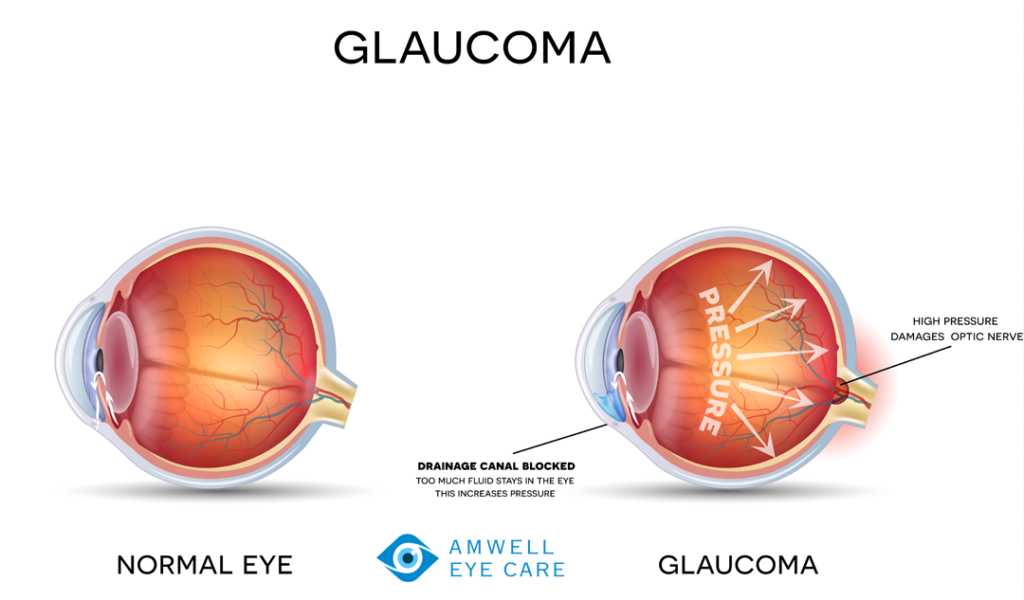12 Jul Glaucoma: Facts You Should Know
What is glaucoma?
Glaucoma is a group of diseases that can deteriorate the eye’s optic nerve resulting in vision loss and blindness. It is the second-leading cause of blindness in the U.S. Usually, glaucoma occurs when the fluid inside the eyes are abnormally high. As the fluid builds up, the pressure inside the eye rises to a level that is damaging to the optic nerve. Initially, glaucoma affects peripheral or side vision, but central vision will be affected as the disease advances. If left untreated, glaucoma can lead to severe vision loss and blindness.

What is the optic nerve?
The optic nerve carries more than 1 million nerve fibers that connects from the back of your eye to the brain. The retina is the light-sensitive nerve tissue at the back of the eye, which transmits light into electrochemical signals allowing vision to take place. A healthy optic nerve is essential for good vision.
How is glaucoma diagnosed?
Glaucoma is detected through a comprehensive eye exam that includes the following tests
- Visual acuity. The eye chart detects how well you at various distances.
- Visual field testing. This measures the extent of your field of view, especially your peripheral (side) vision.
- Tonoemtry detects the fluid pressure inside the eyes to screen for glaucoma.
- Pachymetry refers to the thickness of the cornea. Thinner corneas are at a higher risk.
- Dilated eye exam allows the doctor to evaluate the back of the eye for signs of damage and other eye problems.
- Additional diagnostic testing may include photographs and computerized scans of the optic nerve, to monitor any anatomical changes over time.
What are the different types of glaucoma?
The most common form of glaucoma, open angle glaucoma, is a chronic condition that develops slowly and usually without any symptoms. Many people are not aware they have the condition until the disease is very advanced where there is significant vision loss, hence the name “silent thief of sight”.
Angle-closure glaucoma, although rare, usually occurs due to a sudden increase of pressure in the eye caused by a blockage of the drainage system. Symptoms include severe eye pain and nausea, redness in the eye, colored rings around lights and blurred vision. This is a medical emergency in which severe vision loss can occur in as few as one or two days, see your doctor immediately.
In low-tension or normal-tension glaucoma, optic nerve damage and vision loss occur despite eye pressure remains within the normal range. The exact cause remains unknown. Theories from the medical literature include highly sensitive optic nerve and poor blood flow.
Congenital glaucoma occurs in babies who are born with a defect in the drainage system. Symptoms include cloudy eyes, sensitivity to light, and excess tearing. The presence of enlarged corneas is also highly suggestive of such diagnosis. Congenital glaucoma is usually diagnosed within the first year of life. While the exact mechanism of cause is not clearly understood, most cases are inherited.
Secondary glaucomas develop as complications of other medical conditions. These types of glaucoma are usually associated with physical injuries and eye abnormalities, eye surgery, certain eye tumors or uveitis (eye inflammation).
What are the symptoms of glaucoma?
At first, open-angle glaucoma presents itself symptomless. No pain is experienced. Vision stays normal. As glaucoma advances without treatment, peripheral (side) vision is slowly deteriorated causing people to miss objects to the side and out of the corner of their eye. Little by little, the progressive vision loss will result in “tunnel vision” where only straight-ahead vision remains. Over time, central vision will also be affected until no vision remains.

Who is at risk for glaucoma?
Some people are at higher risk than others. They include
- Over age 40.
- African or Hispanic heritage.
- Family history of glaucoma.
- History of previous eye injury.
- History of high amount of nearsightedness or farsightedness.
- History of corticosteroids use (include including cortisone, hydrocortisone and prednisone)
A comprehensive eye exam with dilation may reveal more risk factors such as high eye pressure, thinness of the cornea, abnormal anatomy of the drainage system, and abnormal optic nerve anatomy.
Can glaucoma be cured?
Unfortunately, there is no cure for glaucoma currently. Damage from glaucoma is irreversible, therefore vision loss from the disease cannot be restored. However, if detected early, you can often protect your eyes against progressive vision loss.
Can glaucoma be treated?
Yes. Controlling and managing the pressure inside the eye is the number one goal. Early intervention can certainly delay the progression of the disease. Treatment options include medicines in the form of eye drops or pills, laser treatment, conventional surgery or a combination of any of these. While these treatments aim to preserve the remaining vision, they do not improve vision loss already damaged from glaucoma. Once diagnosed, it is imperative to follow treatment diligently and see your doctor regularly as treatment may need to be adjusted depending on the condition of the disease.



